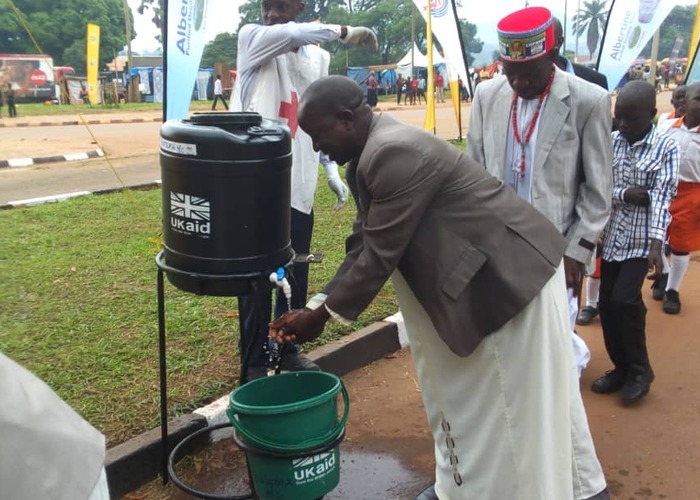Uganda steps up fight against Ebola
Jun 12, 2019
As part of the precautionary measures, Kampala and Wakiso have been included as Ebola high-risk districts, given the trade relations between the two countries.

Ebola is not new to Uganda. Since 2000, Uganda has had five Ebola outbreaks, the last being in 2012 and has been able to combat the disease.
After 10 months of preparedness against the Ebola Virus Disease (EVD), that is currently ravaging neighbouring Democratic Republic of Congo (DRC), the Health Ministry on Tuesday registered its first case of the disease in Kasese district after a five-year-old Congolese child returning to Uganda from DRC through Bwera border post tested positive of Ebola.
Ebola, currently ravaging eastern DR Congo, particularly the Beni region, 50km from the Ugandan border.
The outbreak declared in August has recorded more than 2,000 Ebola cases in eastern DR Congo, two-thirds of them fatal.
Vaccination of health workers
It is against this background that Health Minister Jane Ruth Aceng on Tuesday announced ring vaccination of contacts to the case and other non-vaccinated frontline health and other workers will be undertaken beginning this Friday (14 June).
This is with support from the World Health Organisation (WHO) and the Centre for Disease Control (CDC).
The vaccine to be administered to contacts or frontline health and other workers, according to the ministry, is very safe and effective.

Therefore, persons identified for vaccination have been urged to willingly take the vaccine for their own and family protection.
Uganda embarked on vaccinating health workers, working in Ebola high-risk districts in December last year, to counter the spread of the disease. A total of 4,000 health workers have so far been vaccinated.
The high-risk districts include; Buliisa, Bundibugyo, Bunyangabu, Hoima, Kanungu, Kasese, Kisoro, Kabarole, Kikube and Pakwach.
Several international donors have also supported Uganda Uganda's plans to prevent an outbreak. These include the United Kingdom, European Unions, Ireland and the United States of America.
The UK last year, provided 5.1m pounds (approximately sh25b) towards the fighting Ebola in Uganda. It also provided transport equipment such as ambulances and motorbikes to support the management of suspected cases.
Cross border movement
The hurdle, however, is that thousands of people cross the 15 border points between the two countries, particularly on midweek market days. Some people have also continued to use porous borders to access the country, thus missing screening at given points, according to Richard Okwi, a senior sociologist at the health ministry.
Uganda is also a host to many refugees from DRC.
As part of the precautionary measures, Kampala and Wakiso have been included as Ebola high-risk districts, given the trade relations between the two countries.
Douglas Lubowa, a communication for development emergency consultant with UNICEF said the challenge for Kampala and Wakiso though, is that whereas people are conscious, they cannot associate the risks to the people they relate with because there is a level of detachment and this is very dangerous.
Kisoro, for example, the main entry for refugees from DRC, has up to 13 buses that ferry people from DRC to Kampala.

It is in this light that the ministry re-echoed its call on the public to cooperate with the immigration, health and security officials to ensure effective screening at all entry points to prevent the spread of Ebola to other parts of the country.
Local authorities have also been empowered to inform communities about the importance of screening.
Meanwhile, the World Health Organization has announced that a key emergency committee would meet following confirmation that an Ebola outbreak in the Democratic Republic of Congo had spread to Uganda.
Reports from Geneva indicate that the panel will meet on Friday to determine whether to declare the outbreak "a public health emergency of international concern," a major shift in mobilisation against the disease, it said.
WHO's emergency committee had in October and again in April held off declaring the DRC epidemic an emergency of international concern, in part because the virus remained contained in one part of DRC.
For the committee to make the emergency call, it must determine that the epidemic "carries implications for public health beyond the affected State's national border and may require immediate international action," according to WHO.
What is Ebola?
Ebola Virus Disease is a haemorrhagic fever that is highly infectious and is transmitted by direct contact with the blood, body fluids and tissues of infected persons.
Transmission of the Ebola virus has also occurred by handling sick or dead infected wild animals (chimpanzees, gorillas, monkeys, forest antelope, fruit bats), according to WHO.
It is also a severe acute viral illness often characterized by the sudden onset of fever, intense weakness, muscle pain, headache and sore throat.
This is followed by vomiting, diarrhoea, rash, impaired kidney and liver function, and in some cases, both internal and external bleeding.
As the virus spreads through the body, it damages the immune system and organs and ultimately causes levels of blood-clotting cells to drop, killing up to 90% of people who are infected.
Incubation
The incubation period, that is, the time interval from infection with the virus to onset of symptoms, is from 2 to 21 days, according to WHO. A person infected with Ebola cannot spread the disease until they develop symptoms.
Vaccine
An experimental Ebola vaccine proved highly protective against EVD in a major trial in Guinea in 2015. The vaccine, called rVSV-ZEBOV, was studied in a trial involving 11 841 people.
Among the 5837 people who received the vaccine, no Ebola cases were recorded 10 days or more after vaccination. In comparison, there were 23 cases 10 days or more after vaccination among those who did not receive the vaccine.
The rVSV-ZEBOV vaccine is being used in the ongoing 2018-2019 Ebola outbreak in DRC. Initial data indicate that the vaccine is highly effective.
The average EVD case fatality rate is around 50%. Case fatality rates have varied from 25% to 90% in past outbreaks.
